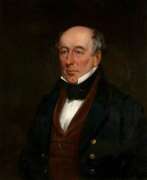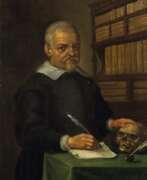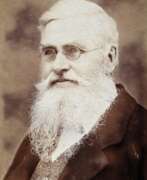Zoologists


George Robert Gray was a British zoologist.
Gray practiced ornithology and scales, and for forty years headed the ornithology department of the British Museum, now the Natural History Museum, in London. Gray's major work on ornithology is entitled Genera of Birds (1844-1849), and is decorated with illustrations by David William Mitchell and Joseph Wolf. Gray also described many species of scales, and in 1833 became a founding member of the Royal Entomological Society of London.


William Jardine was a Scottish naturalist, ornithologist, ichthyologist, artist and publisher of works on zoology.
Jardine studied medicine at the University of Edinburgh and was an excellent sportsman. Although his main passion was ornithology, he also studied ichthyology, botany and geology. Sir William Jardine was a prominent Scottish Victorian naturalist, author and publisher of 40 volumes of the popular Naturalist's Library (1833-43). Of these, 14 volumes were devoted to ornithology, 13 volumes to mammals, 7 volumes to entomology, and 6 volumes to ichthyology.
A series in four volumes, Illustrations on Ornithology, co-written with Prideaux John Selby, was published between 1825 and 1843. His book on burrows and fossil tracks, The Ichnology of Annandale, includes fossils from his ancestral estate. Jardine was a leading expert on salmon and trout in the British Isles. His outstanding knowledge of the species was profound that in 1860 he was appointed a member of the Royal Commission on the Salmon Fisheries of England and Wales. His research culminated in the best and most comprehensive monograph on these fish, "British Salmonids," with the remarkable illustrations by Jardine himself. William Jardine's private natural history museum and library are considered the finest in Britain.


François Levaillant was a French ornithologist, traveler and writer.
Levaillant was born in Dutch Guiana, where his father was French consul. He returned with his family to France, where he eventually became a dealer in natural history specimens. At the age of 27, trained as an ornithologist, he traveled to southern Africa with the Dutch East India Company to collect specimens for his collection. Levaillant was one of the first naturalist explorers to venture into uncharted and dangerous Africa to see and study birds in their natural habitat.
Returning to France in 1785 after several years of traveling, he began writing ornithological works based on his diaries. His Histoire naturelle des perroquets (Natural History of Parrots) was published between 1801 and 1805, and his six-volume History of the Nature of Africa was published between 1799 and 1808. Levaillant also wrote the popular book Le Vaillant's Voyage to the Interior of Africa and others. He was one of the first Europeans to make ethnographic observations, empathizing with African peoples and treating them as equals.


Marcello Malpighi was an Italian biologist, anatomist and physician, professor of logic, theoretical and practical medicine, and a member of the Royal Society of London.
After graduating from the University of Bologna with the degree of Doctor of Medicine and Philosophy, Malpighi soon took up a professorship there, then taught at the universities of Pisa and Messina. At the same time as teaching, he conducted biological research with his microscopes, which was an innovation in those days. In 1661, he identified and described the pulmonary and capillary network connecting small arteries to small veins, one of the most important discoveries in the history of science. He also isolated taste buds and regarded them as nerve endings, described the minute structure of the brain, the optic nerve, and in 1666 was the first to see red blood cells and attribute to them the color of blood. His treatise De polypo cordis (1666) explained the composition of blood and how it coagulates.
During his medical practice, Malpighi studied microscopic sections of the liver, brain, spleen, kidneys, and the bone and deep layers of skin that now bear his name. In his landmark 1673 work on the embryology of the chicken, the scientist concluded that the embryo forms in the egg after fertilization. In 1675-79 he also made extensive comparative studies of the microscopic anatomy of several different plants and saw analogies between plant and animal organisms. The Royal Society of London published two volumes of his botanical and zoological works in 1675 and 1679. His Anatome Plantarum is richly decorated with engravings by Robert White.
After his house was burned and looted by his adversaries, in 1691 Pope Innocent XII invited him to Rome as papal personal physician, which was a great honor.
Malpighi can be considered the first histologist. For almost 40 years he used the microscope to describe the main types of plant and animal structures and thus marked for future generations of biologists the main directions of research in botany, embryology, human anatomy and pathology. The conflict between ancient ideas and modern discoveries continued throughout the seventeenth century. Malpighi was convinced that microscopic anatomy, by showing the minute structure of living things, questioned the value of the old medicine. He laid the anatomical foundation for the subsequent understanding of human physiological exchanges.


Thomas Martyn was a British zoologist, conchologist and entomologist.
Thomas Martyn was the founder of the Academy of Painted Natural History in London - for young men "possessing a natural talent for drawing and painting, to be developed under his immediate sole direction" in the art of describing natural history. He published several illustrated volumes on botany, entomology, and history.
In 1784 Martyn began his major work, The Universal Conchologist. He acquired a large number of shells brought back from Cook's third voyage, many of which are illustrated in the book along with specimens from other famous collections. Originally publishing the work in 1784 as two volumes devoted mainly to shells from the South Seas, Martyn later expanded the work to a four-volume set in French and English containing 160 plates.


August Johann Rösel von Rosenhof was a German entomologist and zoologist, naturalist and miniature painter.
He graduated from the Nuremberg Academy of Artists and was practicing miniature painting and printmaking when he became acquainted with the works of the artist and entomologist Maria Sibylla Merian. Her famous Surinam book of 1705 inspired Rösel to create a similar book, but with illustrations of the plants and animals of Germany.
Rösel began to study natural sciences, he collected insects, caterpillars and butterflies, observed their metamorphosis and wrote down his observations accompanied by pictures. From 1740 Rösel published the results of his scientific and artistic work: the Monthly Entertainments of Insects, in four volumes. He also published Historia naturalis Ranarum nostratium, devoted to the frogs of Germany. In the quality of the illustrations this book is one of the most beautiful about these animals.


Marco Aurelio Severino was an Italian surgeon, anatomist and zoologist, one of the founders of comparative anatomy.
From childhood Severino studied Latin, Greek, rhetoric, poetry and law in various schools in Calabria, then continued his studies in Naples, soon moving from law to medicine. In Naples he met Tommaso Campanella, who had a great influence on the formation of his worldview. After receiving a medical degree in Salerno in 1606, he studied surgery in Naples with Giulio Jasolino. In 1615 Severino was appointed the first surgeon at Ospedale degli Incurabili. Severino made significant contributions to the transformation of naturophilosophy, medical and surgical practice, to which much of his printed work is devoted.
Severino's main contribution, however, lies in his anatomical works, especially the Zootomia Democritea. This work may be called the earliest comprehensive treatise on comparative anatomy. Severino is considered one of the pioneers of comparative anatomy.
Severino's cultural interests extended far beyond medicine. He corresponded with many prominent physicians and scientists of his time, including William Harvey and John Houghton in England, Thomas Bartolin and Ole Worm in Denmark, J.G. Volkamer and Johannes Wesling in Germany, and Campanella, Jasolino, and Tommaso Cornelio in Italy. Severino was tried by the Inquisition for allegedly unorthodox religious and philosophical views, but was eventually acquitted. He died of the plague in Naples.


Jan Swammerdam was a Dutch naturalist and biologist, anatomist and microscopist.
Swammerdam graduated from the Faculty of Medicine at Leiden University, then studied in Paris, earning a doctorate in medicine, and devoted himself exclusively to microscopic research. He used a single-lens microscope to study insect anatomy, and accurately described and illustrated the life history and anatomy of many species. His observations of their development allowed him to divide insects into four major divisions according to the degree and type of metamorphosis. His greatest contribution to biology was to understand insect development and to demonstrate that the same organism persists through different stages.
Jan Swammerdam wrote a voluminous work entitled A General History of Insects (1669) and The Bible of Nature (1737-1738), one of the finest collections of microscopic observations ever published. Considered the most accurate of the classical microscopists, he was the first to observe and describe erythrocytes in 1658.
Swammerdam was also a recognized anatomist: in 1670 he was granted the privilege of dissecting human bodies in Amsterdam, which at the time required a special license available only to a limited number of researchers. He developed a new dissection technique and also designed several new instruments.



















